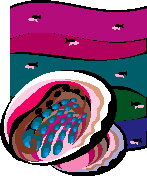


In nature there is a material known as nacre. Nacre makes up most
shells and is made up of layers of calcium carbonate interwoven
with
layers of organic glue. You might think of the napoleon, a pastry
that
is made up in somewhat the same way, but without the glue and of a
softer material. In nacre the layers are  incredibly
thin--about
the width of a wavelength of
light, which is why shells made of nacre reflect a rainbow of
colors
(like in an abalone). A crack cannot run through the nacre,
because
when it gets started it hits a glue layer and is stopped. That
makes
the nacre incredibly hard to break and virtually impossible to
shatter--the ideal bone material.
incredibly
thin--about
the width of a wavelength of
light, which is why shells made of nacre reflect a rainbow of
colors
(like in an abalone). A crack cannot run through the nacre,
because
when it gets started it hits a glue layer and is stopped. That
makes
the nacre incredibly hard to break and virtually impossible to
shatter--the ideal bone material.
Biomimetics is the art and science of transforming biological designs into human use. So far no one has been able to make synthetic nacre, but a major push is being made to do so. There is a huge need to be able to make hips and knees and other bone parts that act more like bone. It is remarkable that in studying bone we have been able to see how incredible it is, and when we look for a material to replace bone we find that it is present in sea shells and not in metallic fabricating plants. The materials God uses in making his creatures is of the highest quality, and man is challenged in his attempts to come close to that original.
--Reference: Scientific American, June 2006, page 28.
Back to Contents Does God Exist?, MayJun08.